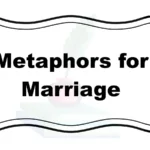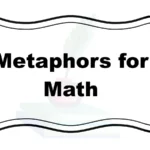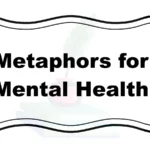Math is more than just numbers—it’s a language of patterns, ideas, and creativity. Sometimes, the best way to truly connect with math is to describe it with metaphors that spark imagination. Just like poetry helps us express emotions, metaphors for math can make this subject feel more alive, personal, and approachable.
When we compare math to everyday experiences—like solving puzzles, painting pictures, or planting seeds—it becomes less intimidating and more relatable. These metaphors not only help students understand concepts better but also allow teachers, parents, and learners to express math in a way that feels warm, caring, and meaningful.
1. Math is a Puzzle
Meaning: Math is like a jigsaw puzzle where every piece fits perfectly.
Explanation: Just as a puzzle requires patience and logical thinking, solving math problems needs careful steps and connections.
Example: “Learning algebra felt like piecing together a giant puzzle.”
Other Ways to Say:
- Math is a riddle.
- Math is a code to crack.
- Math is a mystery box.
2. Math is a Language
Meaning: Math communicates ideas universally, beyond spoken words.
Explanation: Just like English or Spanish, math uses symbols and grammar to share meaning.
Example: “Geometry is the language of shapes.”
Other Ways to Say:
- Math is universal speech.
- Math is the alphabet of logic.
- Math is symbolic conversation.
3. Math is a Map
Meaning: Math guides you, showing different paths to a solution.
Explanation: Like a map shows directions, equations guide us to answers.
Example: “Fractions are the map that led me to better cooking measurements.”
Other Ways to Say:
- Math is a compass.
- Math is a GPS for logic.
- Math is a road to solutions.
4. Math is a Mirror
Meaning: Math reflects the patterns of the world.
Explanation: From nature to architecture, math mirrors reality in numbers.
Example: “The Fibonacci sequence is a mirror of nature’s design.”
Other Ways to Say:
- Math is a reflection.
- Math is a lens.
- Math is a window.
5. Math is a Game
Meaning: Solving math problems is like playing strategy games.
Explanation: Just like chess or Sudoku, math requires rules, logic, and creativity.
Example: “For me, calculus is a mental game of strategy.”
Other Ways to Say:
- Math is play.
- Math is a contest of logic.
- Math is a brain sport.
6. Math is a Recipe
Meaning: Math has formulas just like cooking has recipes.
Explanation: By following steps, you reach the same result consistently.
Example: “Geometry was like following a recipe for perfect patterns.”
Other Ways to Say:
- Math is cooking instructions.
- Math is a formula book.
- Math is step-by-step creation.
7. Math is a Bridge
Meaning: Math connects different fields of knowledge.
Explanation: Like a bridge links two lands, math links science, technology, and art.
Example: “Math is the bridge between physics and engineering.”
Other Ways to Say:
- Math is a link.
- Math is a connector.
- Math is a pathway.
8. Math is Music
Meaning: Numbers and rhythms create harmony like music.
Explanation: Both math and music rely on patterns, timing, and structure.
Example: “Algebra feels like the hidden music of logic.”
Other Ways to Say:
- Math is rhythm.
- Math is harmony.
- Math is a silent song.
9. Math is a Seed
Meaning: Math grows into new knowledge when nurtured.
Explanation: Like planting a seed, small math concepts expand into bigger ideas.
Example: “Multiplication is the seed that grows into algebra.”
Other Ways to Say:
- Math is the root.
- Math is a sprout of knowledge.
- Math is a tree of logic.
10. Math is a Tool
Meaning: Math helps us solve real-world problems.
Explanation: Just like a hammer builds, math builds solutions.
Example: “Statistics is the tool that helps us understand trends.”
Other Ways to Say:
- Math is an instrument.
- Math is a gadget.
- Math is a utility.
11. Math is a Key
Meaning: Math unlocks hidden knowledge.
Explanation: Just like a key opens a locked door, math opens doors to science, technology, and deeper understanding.
Example: “Algebra was the key that unlocked physics for me.”
Other Ways to Say:
- Math is a passcode.
- Math is a door-opener.
- Math is an access tool.
12. Math is a Journey
Meaning: Math is a path of discovery.
Explanation: Learning math takes time, effort, and exploration—like traveling to new places.
Example: “Every equation is a step forward in my math journey.”
Other Ways to Say:
- Math is an adventure.
- Math is a path.
- Math is a road.
13. Math is a Building Block
Meaning: Math is the foundation for knowledge.
Explanation: Just like bricks form a building, math concepts stack together to build understanding.
Example: “Multiplication is a building block for algebra.”
Other Ways to Say:
- Math is a foundation.
- Math is a cornerstone.
- Math is a stepping stone.
14. Math is a Treasure Hunt
Meaning: Math hides answers waiting to be found.
Explanation: Like searching for treasure, solving problems requires clues, patience, and discovery.
Example: “Geometry felt like a treasure hunt of hidden patterns.”
Other Ways to Say:
- Math is a quest.
- Math is a search for gold.
- Math is a hunt for answers.
15. Math is a Machine
Meaning: Math processes inputs to create outputs.
Explanation: Like a machine, math takes numbers, applies rules, and produces solutions.
Example: “Algebra is the machine that turns equations into results.”
Other Ways to Say:
- Math is an engine.
- Math is a calculator.
- Math is a processor.
16. Math is a Web
Meaning: Math connects everything together.
Explanation: Just like a spider’s web links threads, math connects subjects, ideas, and real-life problems.
Example: “Probability is the web that connects risk to decision-making.”
Other Ways to Say:
- Math is a network.
- Math is an interconnected net.
- Math is a system of threads.
17. Math is a Story
Meaning: Math tells a narrative through numbers.
Explanation: Each problem has a beginning, a challenge, and a resolution—like a story.
Example: “Statistics tells the story behind the data.”
Other Ways to Say:
- Math is a tale.
- Math is a narrative.
- Math is a history in numbers.
18. Math is a Ladder
Meaning: Math helps us climb to higher knowledge.
Explanation: Each rung represents a new concept, and the more you climb, the more you see.
Example: “Fractions were the ladder to learning algebra.”
Other Ways to Say:
- Math is a staircase.
- Math is a climb.
- Math is a rise to knowledge.
19. Math is a Mirror of Logic
Meaning: Math reflects pure reasoning.
Explanation: Just as a mirror shows truth, math shows the accuracy of logic.
Example: “Geometry is a mirror of logical thinking.”
Other Ways to Say:
- Math is pure reasoning.
- Math is truth’s mirror of truth.
- Math is logic’s reflection.
20. Math is a Garden
Meaning: Math grows with care and attention.
Explanation: Like planting seeds, learning math step by step produces beautiful results.
Example: “Studying calculus felt like nurturing a growing garden of knowledge.”
Other Ways to Say:
- Math is a field of growth.
- Math is a landscape of logic.
- Math is a blooming mind.
21. Math is a Playbook
Meaning: Math provides strategies like a coach’s guide.
Explanation: Every formula is like a move in a sports playbook.
Example: “Trigonometry was my playbook for solving navigation problems.”
Other Ways to Say:
- Math is a guide.
- Math is a rulebook.
- Math is a strategy book.
22. Math is a Mirror of Nature
Meaning: Nature follows math’s rules.
Explanation: From seashell spirals to galaxy curves, math reflects nature’s beauty.
Example: “The Fibonacci sequence is math’s mirror in sunflowers.”
Other Ways to Say:
- Math is a pattern of nature.
- Math is nature’s code.
- Math is a natural rhythm.
23. Math is a Toolkit
Meaning: Math equips us with skills to solve problems.
Explanation: Like tools in a box, formulas and concepts are instruments for different tasks.
Example: “Algebra is a toolkit that helps engineers build solutions.”
Other Ways to Say:
- Math is an arsenal.
- Math is a toolbox.
- Math is a resource kit.
24. Math is a Playground
Meaning: Math is a space for creativity and fun.
Explanation: Like a playground, math lets us explore, experiment, and imagine.
Example: “Geometry felt like a playground of shapes.”
Other Ways to Say:
- Math is a sandbox.
- Math is a field of play.
- Math is a fun space.
25. Math is a Bridge to the Future
Meaning: Math prepares us for progress.
Explanation: Like a bridge connecting past and future, math builds innovation.
Example: “Math is the bridge to technological advancements.”
Other Ways to Say:
- Math is a link to tomorrow.
- Math is a gateway.
- Math is the path to innovation.
26. Math is a Lighthouse
Meaning: Math guides us through confusion.
Explanation: Just like a lighthouse helps ships, math directs us to safe answers.
Example: “Formulas are the lighthouse in the storm of confusion.”
Other Ways to Say:
- Math is a beacon.
- Math is a guiding light.
- Math is a signal of clarity.
27. Math is a Building
Meaning: Each concept builds upon another.
Explanation: Like constructing floors, math stacks knowledge into tall structures.
Example: “Algebra is the foundation, and calculus is the top floor.”
Other Ways to Say:
- Math is a skyscraper.
- Math is a structure.
- Math is a tower of knowledge.
28. Math is a Labyrinth
Meaning: Math is a maze with many paths.
Explanation: Some paths lead to dead ends, but with persistence, you find the solution.
Example: “Algebra felt like a labyrinth of symbols.”
Other Ways to Say:
- Math is a maze.
- Math is a winding path.
- Math is a puzzle corridor.
29. Math is a Dance
Meaning: Math flows with rhythm and balance.
Explanation: Like dancing, math requires steps, timing, and coordination.
Example: “Geometry was a graceful dance of angles and lines.”
Other Ways to Say:
- Math is choreography.
- Math is rhythm in motion.
- Math is a balanced movement.
30. Math is a Candle
Meaning: Math lights the way to knowledge.
Explanation: Just as a candle brings clarity in darkness, math reveals answers to questions.
Example: “Statistics was the candle that lit my path in research.”
Other Ways to Say:
- Math is a torch.
- Math is illumination.
- Math is light in the dark.
Conclusion:
Math is not just about equations and numbers—it’s about finding meaning in patterns, exploring possibilities, and connecting with the world around us. By using metaphors, we make math more relatable, turning abstract concepts into stories, journeys, and experiences we can all understand. Whether you see math as a puzzle, a map, a key, or a dance, each perspective opens new ways of appreciating its beauty. Metaphors remind us that math is not only logical but also creative, human, and full of wonder. The next time you talk about math, try using one of these metaphors—you may find it sparks curiosity, joy, and deeper connection.
MCQs:
Q1. Which metaphor describes math as something that grows into larger ideas?
a) Math is a tool
b) Math is a seed
c) Math is a mirror
d) Math is a map
Answer: b) Math is a seed
Q2. If math is compared to music, what does this metaphor highlight?
a) Confusion
b) Harmony and rhythm
c) Strength
d) Directions
Answer: b) Harmony and rhythm
Q3. “Math is a puzzle” suggests math requires:
a) Random guessing
b) Careful thinking and patience
c) Creativity without logic
d) Copying answers
Answer: b) Careful thinking and patience
Q4. Which metaphor explains math as a universal way to communicate?
a) Math is a game
b) Math is a bridge
c) Math is a language
d) Math is a tool
Answer: c) Math is a language
Q5. If math is a map, what does it provide?
a) Entertainment
b) Directions to solutions
c) Secrets of music
d) Growth like a plant
Answer: b) Directions to solutions
Q6. Which metaphor reflects nature’s patterns?
a) Math is a mirror
b) Math is a ladder
c) Math is a machine
d) Math is a key
Answer: a) Math is a mirror
Q7. “Math is a recipe” suggests:
a) Math requires ingredients and steps
b) Math is a random guess
c) Math cannot be learned
d) Math is unpredictable
Answer: a) Math requires ingredients and steps
Q8. Which metaphor shows math as connecting different fields?
a) Math is a dance
b) Math is a bridge
c) Math is a candle
d) Math is a web
Answer: b) Math is a bridge
Q9. Which metaphor shows math as processing inputs to outputs?
a) Math is a mirror
b) Math is a game
c) Math is a machine
d) Math is a garden
Answer: c) Math is a machine
Q10. “Math is a story” means:
a) Math tells a narrative with a beginning and end
b) Math has no structure
c) Math is boring to read
d) Math is unrelated to life
Answer: a) Math tells a narrative with a beginning and end
Q11. Which metaphor shows math as unlocking hidden knowledge?
a) Math is a ladder
b) Math is a key
c) Math is a map
d) Math is a seed
Answer: b) Math is a key
Q12. “Math is a journey” suggests that learning math is:
a) A quick task
b) A long process of discovery
c) A mystery without answers
d) A simple game
Answer: b) A long process of discovery
Q13. Which metaphor compares math to a foundation for knowledge?
a) Math is a mirror
b) Math is a building block
c) Math is a dance
d) Math is a lighthouse
Answer: b) Math is a building block
Q14. “Math is a treasure hunt” highlights math as:
a) A boring activity
b) A search for hidden answers
c) A simple recipe
d) A ladder of steps
Answer: b) A search for hidden answers
Q15. If math is described as a lighthouse, it means math:
a) Confuses learners
b) Guides people to clarity
c) Is an endless maze
d) Is fun like a playground
Answer: b) Guides people to clarity
FAQs:
Q1. Why are metaphors useful in math?
Metaphors help make abstract math concepts more relatable and easier to understand. When we compare math to everyday experiences—like puzzles, journeys, or music—it becomes less intimidating and more engaging.
Q2. Can metaphors really improve learning math?
Yes! Metaphors allow learners to visualize and connect math with real life, which helps memory and comprehension. For example, seeing equations as “puzzles” makes problem-solving feel fun rather than stressful.
Q3. Which metaphor for math is most popular?
One of the most popular is “Math is a language” because math communicates ideas universally, just like words do. However, the best metaphor depends on a learner’s personality—creative students may prefer “Math is music”, while explorers may love “Math is a journey.”
Q4. How can teachers use metaphors in math lessons?
Teachers can introduce metaphors when explaining new topics. For example, describing fractions as “slices of pizza” or algebra as a “key that unlocks equations” makes lessons more interactive and memorable.
Q5. Are metaphors in math only for students?
Not at all! Metaphors help students, teachers, parents, and even professionals. They make math feel human and approachable, whether you’re solving equations, explaining concepts, or appreciating the beauty of patterns in nature.




